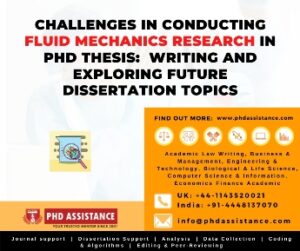Challenges in Conducting Fluid Mechanics Research in PhD Thesis: Writing and Exploring Future Dissertation Topics
INTRODUCTION
Fluid mechanics is the sub discipline in the field of Engineering and physics that describes the flow of fluids like liquids and gases. It has series of sub disciplines, encircling fluid dynamics, aerodynamics and hydrodynamics. Calculating forces and moments on aircraft, estimating the mass flow rate of gasoline through pipelines, forecasting weather patterns, interpreting nebulae in interstellar space, and modelling fission bomb detonation are the broad spectrum of fluid mechanics applications.

PA-Challenges in Conducting Fluid Mechanics Research in PhD Thesis: Writing and Exploring Future Dissertation Topics
Fluid dynamics provides a Formal Framework that underpins this functional discipline, which encompasses empirical and semi-empirical laws derived from flow calculation and applied to real-world problems. The predicaments of fluid dynamics are usually solved by calculating various fluid properties as functions of space and time, such as flow velocity, pressure, density, and temperature.
CHALLENGES IN WRITING A TECHNICAL PHD DISSERTATION
There are numerous constraints in writing your PhD Dissertation, which is likely to be the single largest piece of written work you’ve ever completed. It’s easy to feel frustrated when you’re working on a long Academic Paper, surrounded by people who have thoughts and input and under pressure to write. But don’t give up! Here are several pointers to help you overcome the most popular obstacles you’ll encounter while completing your dissertation in PhD.
Procrastination is an easy pit to fall into, whether you’re binge-watching your favourite show, coping with the easy items on your to-do list, or just daydreaming. Your PhD dissertation cannot, unfortunately, compose itself. However, since procrastination is so popular, there are several resources, including applications available to help you get back on track.
SIMPLE TRICKS TO DRAFT YOUR DISSERTATION IN FLUID MECHANICS
Scheduling your job and play is one such strategy. For a week, keep track of your energy levels and figure out when the best time is to compose. Then put it on your calendar, make to-do lists or keep a planner. Remember to take care of yourself; you won’t be able to compose a decent thesis if you’re tired. When you’re buried under a mountain of papers that need marking, thousands of emails to read, and a meeting with your boss scheduled for tomorrow morning, life may seem especially bleak. Once in a while, do something nice for yourself. Even don’t forget to get some rest!
Results are needed for Writing a PhD Dissertation, and once you have them, you can begin writing. The analysis of your data determines the structure of your thesis and the distribution of chapters. Gathering your created data and looking at how other researchers have presented their data is how you analyse your data. Data is presented using two-dimensional diagrams, such as contour plots or is surfaces, depending on the field of study.
Once you’ve gotten your data into visual graphs, you’ll want to print the plots and examine them to see what kind of trends you can find. The next step is to state your results once the trend or relationship between the studied parameters has been established. The next step is to begin the relationship between the studied parameters in a series of logical statements after you have stated your findings.
Concentrating on the most interesting by writing their mathematical derivations with a significant amount of theory. While the scale of the less valuable ones is determined by their value. You can now begin composing your table of contents. During the writing process, you can make some changes to the layout of your thesis as a result of certain crucial points that were overlooked.
NEEDS TO BE ADDRESSED WHILE WRITING THE DISSERTATION
While English is the primary language of science, it is not the first language of all scientists. If this is the case, writing a PhD thesis in English may seem overwhelming, but there is assistance available. First, see what resources are available at your university: many universities have a writing centre or offer academic writing instruction, or you might find a tutor. If you’re still not sure, try writing in your native language and having it translated from thesis writing experts
Scientific composition, if it were a musical score, would be for an orchestra rather than a soloist. You’ll often find yourself working with others whose suggestions will help you improve your job. However, the procedure can take a long time. The key to maintaining power is to plan ahead. Determine whom you need to receive input from and set deadlines for them. This will not only keep you on track but will also keep you from thinking about when people will respond.
FUTURE TOPICS
The topics might be categorized as “regular” or “advanced” for your convenience. Noticeably, there is no dividing line between the two categories, and the distinction has been made based on the following subjective criteria. When it comes to a daily subject, there is a clear starting Point for Research and various options for how to proceed.
Advanced subjects are more complex, and the complexity of the theory is their primary goal. These ventures necessitate a thorough understanding of/interest in key modelling problems, with the ultimate success relying more on the contribution of original concepts than on mastery of traditional mathematical techniques.
- Non-axisymmetric interactions of drops with solid boundaries
Dynamic contact angle and their effect on the spreading of a finite volume of fluid on a solid surface are the subjects of this title. The findings may provide a macroscopic method for evaluating mathematical models of dynamic wetting in various regimes. The rivulet formation and some stability problems are also potential research topics.
- Oscillating liquid jet
The surface tension of a newly developed free surface is measured using the method of jet vibration proposed by Bohr in 1909. It has the highest time resolution of any method currently in use, and it has become a necessary tool in colloid science. However, it has a major mathematical flaw that is currently being “patched” by ad hoc “calibration.”
- Topological transitions in bubble dynamics
A critical problem in the dynamics of bubbly liquids and other multiphase flows in the capillary breakup of a bubble (e.g. bubble boiling). The title is labelled ‘regular’ here due to recent developments in the general problem of coalescence/breakup, which provide the basis – and thus the ‘starting point’ – for the analysis of bubble dynamics, though it would be equally justifiable to classify this topic as ‘advanced’.
- Flows with topological transitions of flow domains
Rupture of free liquid sheets, the breakup of liquid jets, Coalescence of drops and bubbles, other fluid motions and solid substrate films are all included in this broad category. The problem is that the topological transformation treated in the context of traditional fluid mechanics is synonymous with singularities in the corresponding solutions, making these solutions physically undesirable and resulting in inconsistencies between theoretical and experimental results.
- Formation of free-surface cusps in unsteady flows
Singularity resolution is basically a problem of integrating physics that were not present in the initial formulation. The question of how singularities develop infinite time and how this extra physics can be turned on is of general interest, and the proposed subject considers a specific case in which this question is likely to be answered.
- Dynamic wetting of rough/inhomogeneous surfaces
The key challenge is describing a randomly rough/inhomogeneous solid surface from the perspective of dynamic wetting and creating a self-consistent macroscopically consistent way of modelling this method. The problem is very similar to the averaging problem in multiphase systems mechanics. The subject is extremely important in a variety of industrial applications.
References
- Langum, V., & Sullivan, K. P. (2020). Academic writing, scholarly identity, voice and the benefits and challenges of multilingualism: Reflections from Norwegian doctoral researchers in teacher education. Linguistics and Education, 60, 100883.
- Garnier, P., Viquerat, J., Rabault, J., Larcher, A., Kuhnle, A., & Hachem, E. (2021). A review on deep reinforcement learning for fluid mechanics. Computers & Fluids, 104973.
- Zaganescu, N. F., Zaganescu, R., & Gheorghe, C. M. (2020). Academician CAIUS IACOB–a Brilliant Mathematician Fascinated by Mechanics. INCAS Bulletin, 12(1), 243-248.
- Caltagirone, J. P., & Vincent, S. (2020). On primitive formulation in fluid mechanics and fluid-structure interaction with constant piecewise properties in velocity–potentials of acceleration. Acta Mechanica, 1-17.
- Rodrigues, A. E. (2020). Chemical engineering and environmental challenges. Cyclic adsorption/reaction technologies: Materials and process together!. Journal of environmental chemical engineering, 8(4), 103926.
 Previous Post
Previous Post Next Post
Next Post
